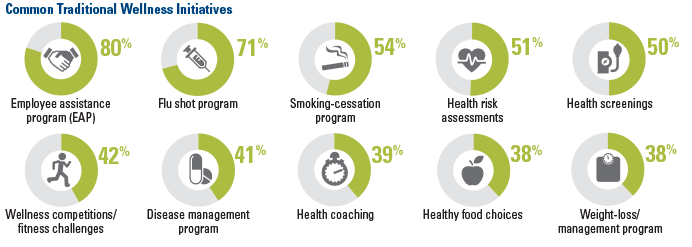Transparency is extremely important to us, so we are letting you know that we may receive a commission on some of links you click on from this page. See our disclaimer.

International Foundation of Employee Benefit Plans
To be sure, businesses continue to employ traditional workplace wellness initiatives, such as health risk assessments, health screening, fitness, flu shots, and more.
But a recent report from the International Foundation of Employee Benefit Plans shows that ” less traditional benefits are quickly taking the stage as top wellness initiatives.”
Last year the group “deployed a survey to members representing corporations, multiemployer trust funds and public employers/governmental entities across the United States and Canada. The study examines the various types of wellness offerings organizations provide to their employees and participants. In total, the survey received 479 completed responses.”
One interesting result comes in the differences the ways U.S. and Canadian firms use wellness programs:
- “U.S. organizations are more likely to offer wellness initiatives for the purpose of controlling health-related costs—Canadian organizations are more likely to focus on investing in worker health and engagement.”
- “U.S. organizations are more likely to offer physical health screening/treatment initiatives and incentives and to be expanding health literacy education, whereas Canadian organizations are more likely to offer many mental health initiatives and mental health communication.”
Not surprisingly, the report states that “diabetes and heart disease are the biggest cost-driving conditions in the United States.”
Other interesting conclusions:
- “More than half of all organizations (55%) have budgets devoted to wellness, and more than four in five offer some type of wellness initiative. Among organizations with wellness offerings, seven years is the average amount of time these efforts have been in place.”
- “Organizations are divided in their purposes and strategies for wellness—59% are primarily offering wellness to invest in/increase worker health and engagement, while 41% aim to control/reduce health-related costs.”
- “More than three in five organizations with wellness budgets (62%) expect their budgets to increase in the next two years.”
- “Flu shot programs (71%), smoking-cessation programs (54%), health risk assessments/appraisals (HRAs) (51%) and health screenings (50%) are among the most popular screening and treatment initiatives.”
- “Wellness competitions (42%), health coaching (39%), healthy food choices (38%) and weight-loss/management programs (38%) are the most prevalent fitness and nutrition wellness initiatives.”





0 Comments